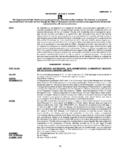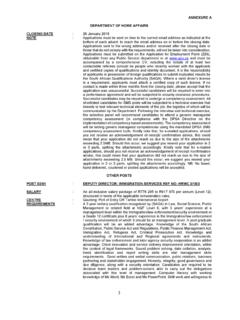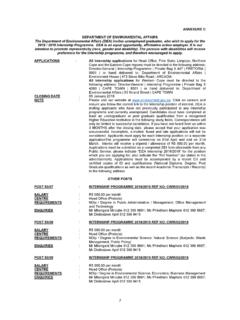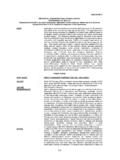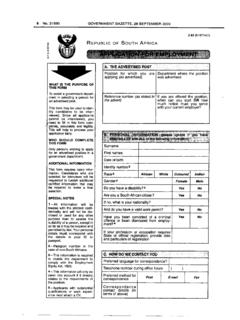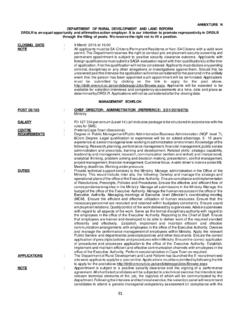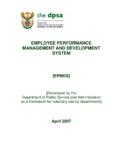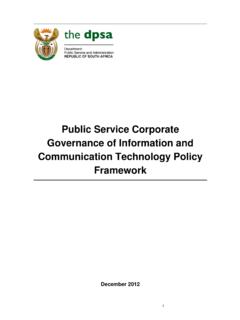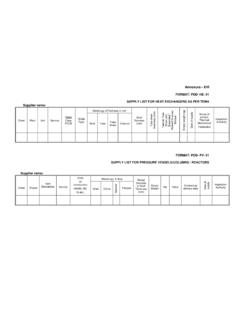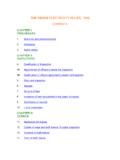Transcription of Annexure A - GRIEVANCE RULES FOR THE PUBLIC …
1 SCHEDULE 1 GRIEVANCE RULES FOR THE PUBLIC SERVICE A. DEFINITIONS In this procedure, unless the context indicates otherwise- Commission means the PUBLIC Service Commission established in terms of section 196[1] of the Constitution; Constitution means the Constitution of the Republic of South Africa, 1996 (Act No. 108 of 1996); days refers to working days; "executing authority" means an authority as defined in subsection 1[1] of the PUBLIC Service Act, 1994; " GRIEVANCE " means a dissatisfaction regarding an official act or omission by the employer which adversely affects an employee in the employment relationship, excluding an alleged unfair dismissal; head of department means the incumbent of a post mentioned in Schedules 1, 2 and 3 of the PUBLIC Service Act, 1994, or the person acting in such post; PUBLIC Service Act means the PUBLIC Service Act, 1994 (Proclamation No 103 of 1994); "recognised trade union" means all the trade unions admitted to the PUBLIC Service Co-ordinating Bargaining Council as well as any other trade union that enjoys the relevant organisational right in particular department; resolve means to settle a GRIEVANCE to the satisfaction of the aggrieved employee.
2 Representative means a fellow employee, a representative or official of a recognised trade union. B. PURPOSE AND APPLICATION 1. The purpose of this GRIEVANCE procedure is to advance sound labour relations and address grievances in the PUBLIC service by fulfilling the primary objectives of this procedure which are: [a] to give effect to section 196(4)(f)(ii) of the Constitution which empowers the Commission to investigate grievances of employees in the PUBLIC service concerning official acts or omissions, and recommend appropriate remedies; [b] to give effect to section 11 of the PUBLIC Service Commission Act, 1997 (Act No. 46 of 1997) which empowers the Commission to make RULES to deal with grievances; [c] to promote - (i) speedy, impartial and equitable handling of grievances; (ii) sound labour relations; (iii) resolution of individual grievances at the lowest possible level in a department. C. MANAGING A GRIEVANCE 1.
3 A GRIEVANCE must as far as possible be resolved by an employer and as close to the point of origin as possible. 2. The employer must ensure that the GRIEVANCE is dealt with in a fair, impartial and unbiased manner, and that the principles of natural justice are observed. 3. The procedure must be such that it assists and enables an employer and an employee to address a dissatisfaction. 4. No employee must be victimised or prejudiced, directly or indirectly, as a result of lodging a GRIEVANCE . 5. If disciplinary action is being taken against an employee, utilisation of this procedure by the employee to address any matter related to the disciplinary action shall not halt the disciplinary procedure. 6. A GRIEVANCE must be lodged in writing and all decisions taken during the process must be in writing. 7. An employee may be assisted by a representative. D. ADHERENCE TO TIME LIMITS 1. In determining adherence to time limits, this should be calculated by excluding the first day and including the last day.
4 2. The parties must adhere to the time limits set out in this procedure, unless they mutually agree to extend them. 3. A GRIEVANCE must be lodged with the employer within 90 days from the date on which the employee became aware of the official act or omission which adversely affects him or her. 4. An employee may demand that his or her GRIEVANCE be referred to the Commission within 10 days after receiving the executing authority s decision. E. PROVISION OF INFORMATION 1. An employer must provide relevant information necessary for an employee to lodge or pursue a GRIEVANCE , if requested. 2. The provision of such information is subject to any limitations imposed by law. 3. The employee must be provided with information about the status of the GRIEVANCE and the progress made towards the planned finalisation date. 4. The employer must provide the employee with a copy of the GRIEVANCE form after each applicable level of authority dealt with the GRIEVANCE .
5 F. DEPARTMENTAL STAGES TO ADDRESS A GRIEVANCE 1. An employee may lodge a GRIEVANCE with an employee designated to facilitate the resolution of grievances in the department. 2. The prescribed form at Annexure A must be used when a GRIEVANCE is lodged. 3. The designated employee must liaise with the relevant structures of authority of the department in an attempt to resolve the GRIEVANCE . 4. The GRIEVANCE may be resolved by any person within the relevant structures of authority who has the requisite authority to do so. 5. The aggrieved employee will be duly informed by the designated employee about the status and progress made towards the resolution of the GRIEVANCE . 6. If the GRIEVANCE is resolved to the satisfaction of the aggrieved employee the confirmation thereof will be reduced to writing by the designated employee. 7. If a GRIEVANCE cannot be resolved, the executing authority must inform the aggrieved employee accordingly.
6 8. The department (including the executing authority) has 30 days to deal with the GRIEVANCE . The period may be extended by mutual agreement in writing. 9. If after the aggrieved employee is informed of the outcome of the GRIEVANCE and he/ she remains dissatisfied - (a) he/ she must inform the executing authority in writing within 10 days; (b) the executing authority must in terms of section 35 (1) of the PUBLIC Service Act, 1994, forward the GRIEVANCE and the relevant documentation to the PUBLIC Service Commission for a recommendation within five days of being informed by the aggrieved employee. 10. If the GRIEVANCE constitutes an alleged unfair labour practice as defined in the LRA, the employee may inform the executing authority in writing that he/ she wishes to utilise the dispute resolution mechanisms provided for in the constitution of the PSCBC or the relevant sectoral council (whichever is applicable) and that the PUBLIC Service Commission should therefore not consider the GRIEVANCE .
7 11. If there is failure on the part of the department to respond to the GRIEVANCE within the period referred to in clause 8, the aggrieved officer may lodge his or her GRIEVANCE with - (a) the Commission directly; or (b) in the case of an alleged unfair labour practice, with the PSCBC or the relevant sectoral council (whichever is applicable) in terms of its dispute resolution procedure. G. REFERRAL TO THE COMMISSION 1. Once the Commission has received all information from the executing authority, it must within 30 days consider such GRIEVANCE and inform the executing authority of its recommendation and the reasons for its decision in writing. 2. On receipt of the Commission s recommendation, the executing authority must, within 5 days, inform the employee and the Commission of his or her decision in writing. H. GRIEVANCE OF HEAD OF DEPARTMENT 1. If a head of department has a GRIEVANCE , he/ she may - (a) in the case of the head of a national department, submit the GRIEVANCE to the President; or (b) in the case of a head of provincial department, submit the GRIEVANCE to the relevant Premier.
8 2. The President or Premier has 30 days to deal with the GRIEVANCE . The period may be extended by mutual agreement. 3. Clause F9 and 10 will, read with the changes required by the context, apply to all grievances of heads of department. I. EVALUATION 1. The head of department must ensure that GRIEVANCE resolution is evaluated by maintaining a record of the number of grievances resolved from the beginning of each calendar year and report to the Commission on a six monthly basis. 2. The Commission must report on the management of grievances and the efficiency of the GRIEVANCE procedure. J. OTHER PROCEDURES When a GRIEVANCE is lodged in terms of this procedure, an aggrieved employee must disclose whether he or she is utilising any other procedure. K. TRANSITIONAL MEASURES 1. A GRIEVANCE lodged before the promulgation of the Interim RULES , namely before 1 July 1999, shall be dealt with and concluded as if the PUBLIC Service Regulations had not been repealed.
9 2. A GRIEVANCE lodged before the promulgation of these GRIEVANCE RULES , must be dealt with and concluded in terms of the Interim GRIEVANCE RULES promulgated in Government Gazette No 20231 of 1999. Annexure A GRIEVANCE FORM PLEASE READ THE FOLLOWING INSTRUCTIONS BEFORE COMPLETING THE FORM 1. This form must be used to lodge a GRIEVANCE (excluding an alleged unfair dismissal) when you are dissatisfied with an official act or omission and you have been unable to resolve the problem by using informal discussion. 2. You have to lodge your GRIEVANCE within 90 days from the date on which you became aware of the official act or omission which adversely affects you. 3. You may be assisted or represented by a fellow employee or a representative or official from a recognised trade union. 4. It is important to complete all information accurately. When the form is completed, it must be given to the employee designated to facilitate grievances at your institution.
10 The department will attach this form to the GRIEVANCE documentation and it will be used through all stages of the GRIEVANCE procedures. 5. At each stage where a person within the relevant structure of authority attempts to resolve the GRIEVANCE , each party will complete the appropriate part of the form. You will be given an opportunity to respond to each and every comment. 6. At the conclusion of each stage of the GRIEVANCE procedure, the department will provide you with a copy of the completed form. 7. Once the GRIEVANCE has been resolved, you do not need to complete the rest of the form. The Human Resources Section of your department will then file the form. It will then be used to report statistics to the PUBLIC Service Commission annually. 8. You are required to complete Parts A and B of this form and to then hand it to the employee designated to facilitate grievances at your institution. The employee will affix his/her signature in the block below part B of the form to indicate that the GRIEVANCE has been received.
